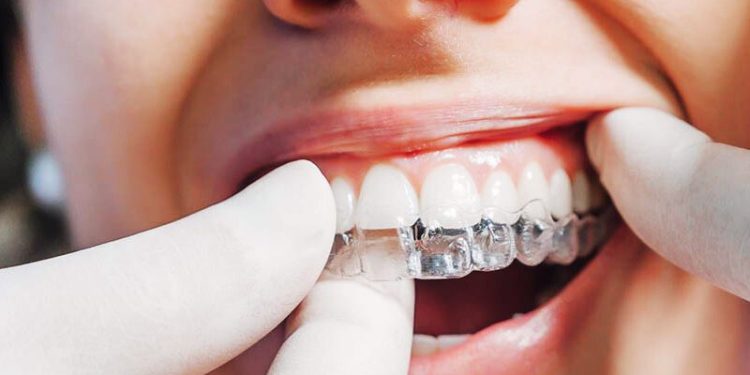1. What are Clear Aligners?
Clear Aligners are orthodontic devices that help to correct crooked or misaligned teeth. If you have crooked or gapped teeth, your orthodontist can suggest orthodontic treatment to fix your teeth’ position and give you a perfect smile. It also helps to correct your bite and prevents oral issues in the future. Various types of dental aligners include the traditional methods and the latest ones.
Let us explore the types of aligners and learn about their function, use and cost.
2. Types of Clear Aligners
Your orthodontist can recommend the following types of braces depending on your case and your preferences:
Metal Braces
They are also known as traditional braces. These braces use metal wires and brackets. They are the most common way to treat your crooked teeth. Your dentist fixes the metal wires and brackets to your teeth till you achieve the perfect smile.
At regular intervals, you need to visit your dentist, and they will adjust your braces as your treatment progresses. You will have to follow regular oral hygiene practices with these braces as food gets accumulated in the braces, which can lead to plaque or tooth decay.
It requires extra care to maintain oral care in good shape. Sometimes, your braces can break or dislocate due to biting and chewing pressure.
They can cause discomfort and pain as they exert pressure on your teeth. Braces might interrupt the way you speak and impact your look while smiling. They can treat mild to complex cases of crooked teeth.
Features of Metal Braces:
Highly visible
Cause discomfort and pain.
Require diet restrictions
More dental visits
Extra care and maintenance
Impacts speech and looks
Ceramic Braces
These braces use wires and brackets like metal ones. They work in a similar way as metal braces. They’re less visible because the brackets and wires are the same color as your teeth.
These braces do not impact the looks as metal wires do. They are less durable than metal ones and can break easily. Hence, they demand more care and restrictions than metal ones.
Features of Ceramic Braces:
Less visible
Cause discomfort and pain.
Require diet restrictions
More dental visits
Extra care and maintenance
Less durable than metal braces
More expensive than metal braces
Lingual Braces
These braces also use metal wires behind your teeth. The wires and brackets are not visible and are perfect for those who care much about their appearance. These braces are more costly than other braces and cause discomfort while speaking.
They cause discomfort while speaking as the braces are placed towards the inner side. In addition, they require a lot of care and maintenance on a daily basis.
Features of Lingual Braces:
Not visible
Cause discomfort and pain.
Require diet restrictions
More dental visits
Extra care and maintenance
More expensive than other braces
Difficulty in speaking
It takes time to adjust to braces.
3. Aligners
These clear aligners are also known as transparent braces. These aligners are the latest way to treat crooked teeth and come with added benefits compared to other alternatives. They are custom-made plastic trays that fit over your teeth.
They are more comfortable and faster than metal braces. In addition, they are removable and allow you to eat everything and carry out your routine easily without interruptions.
You will require several sets of aligners based on your case. As your treatment advances, you will need to switch to a new set of aligners. Your teeth will gradually move into their proper positions, which will address issues with crowding, gaps, overbites, and underbites.
Your teeth’ position will shift, so the following set will differ slightly from the last. You must wear your aligners for at least 22 hours daily for guaranteed results.
Features of Lingual Braces:
Invisible
Comfortable
Removable
No diet restrictions
Fewer Dental Visits
Flexible
Custom made
Adaptable
Predictable
Crack-resistant
Slightly more expensive than other alternatives
Clear dental aligners come with multiple benefits compared to traditional teeth-correcting methods. Choosing clear aligners is worth the cost as they offer a better and more comfortable treatment than other braces, and the entire treatment is planned and monitored digitally. Here are some factors that affect the clear aligners’ cost:
Type of Aligners: Clear aligners typically cost more than metal braces because they’re made with advanced technology and look better. Metal braces are cheaper but require manual adjustments.
Complexity: More severe dental issues mean longer treatment and more sets of aligners, leading to higher costs.
Dentist’s Expertise: Experienced orthodontists may charge more, but they can help achieve better results.
Location of Dental Clinic: Costs can vary depending on where you live and the demand for orthodontic services.
Brand and Quality: Branded aligners with certified materials offer better results and avoid potential problems with lower-quality options.
Beginning your orthodontic journey with dental aligners is an investment in your well-being, confidence, and oral health. While prices for teeth aligners in India vary, it’s crucial to consider factors affecting cost and select the option that fits your needs and preferences.
You can consult your dentist to know the best clear dental aligners in the market that can effectively treat your teeth and give you a perfectly aligned smile.
















